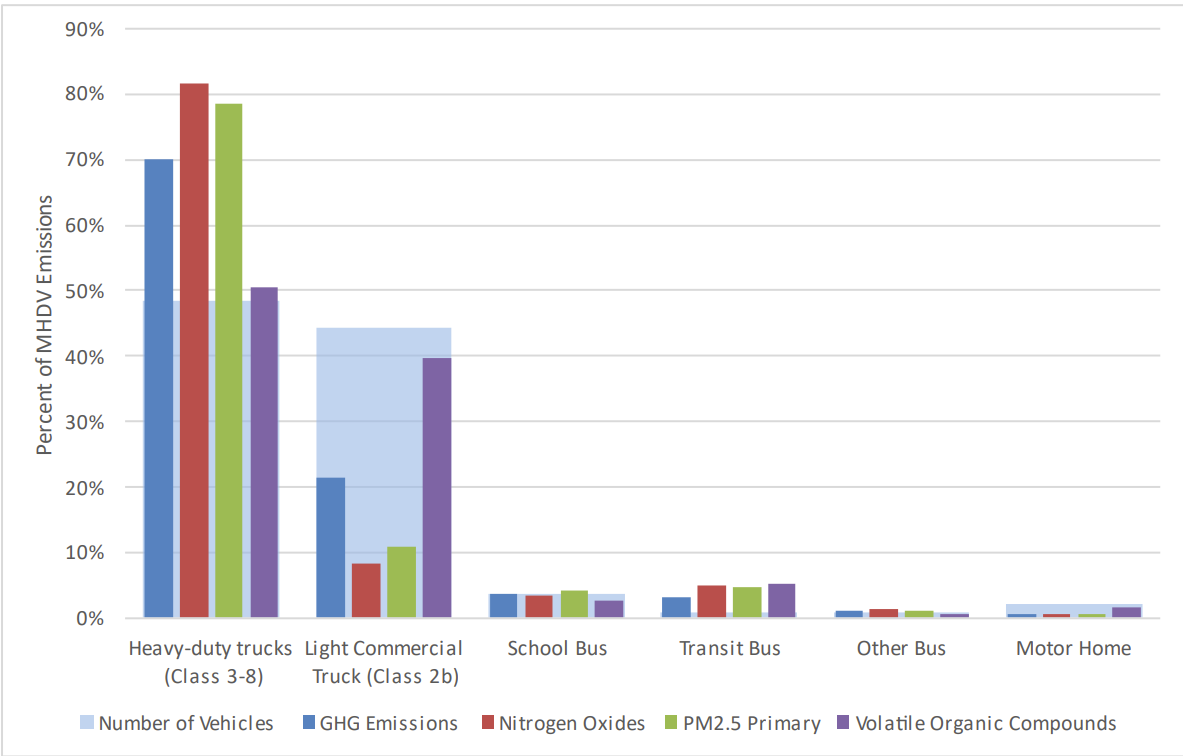
Reducing Transportation Emissions in New Jersey
A Roadmap to Zero-Emission Medium- and Heavy-Duty Vehicles in New Jersey
In May 2024, NJDEP published A Roadmap to Zero-Emission Medium- and Heavy-Duty Vehicles in New Jersey. Read the report to learn more about the state’s vision.
Why Reduce Emissions for Medium and Heavy-Duty Vehicles?
New Jersey is home to approximately 512,500 medium and heavy-duty vehicles. The transportation sector is New Jersey’s largest source of greenhouse gas emissions, accounting for 38% of the state’s emissions total in 2020. While accounting for just four percent of on-road vehicles in the State, MHDVs emit nearly 25%of the greenhouse gas emissions from transportation. Figure 1 shows the emissions contributions of medium- and heavy-duty vehicles relative to their population, illustrating their dramatic impact on the climate. Zero-emission vehicles have no tailpipe emissions and, when compared to diesel vehicles, they are two to five times more efficient, reduce dependence on petroleum, and substantially reduce GHG emissions.
Figure 1. Emissions Contributions of MHD Vehicles, from A Roadmap to Zero-Emission Medium- and Heavy-Duty Vehicles in New Jersey
Goals and Policies
Several goals and policies are guiding our mission to transition to cleaner vehicles. Read examples below:
- USEPA Clean Trucks Initiative (CTI): The USEPA developed the Cleaner Trucks Initiative (CTI) to reduce NOx, particulate matter, and greenhouse gas emissions from heavy-duty trucks through a variety of technological and engine improvements. The CTI will work to ensure emissions reductions occur in the real world in all types of truck operation. CTI rules will offer opportunities to reduce ambient particulate matter and ozone across the country.
- 80×50 Goal: New Jersey’s 80×50 report sets an economy-wide goal to reduce greenhouse gas emissions by 80%below the State’s 2006 baseline by 2050. Decarbonizing MHDVs is a key pathway to meeting the 2050 goal by transitioning 75%of medium-duty and 50%of heavy-duty vehicles to zero-emission by 2050. The report recommends strategies for transitioning to zero-emission vehicles including developing financial incentives, supporting technology research and development, evaluating requirements for zero-emission truck production, requiring fleet turnover to zero-emission trucks, considering the establishment of zero-emission zones around ports, and identifying barriers and solutions to zero-emission vehicle acquisitions.
- Medium-and Heavy-Duty Memorandum of Understanding (MOU) and Action Plan: New Jersey, along with fourteen other states and the District of Columbia, signed on to a memorandum of understanding to promote electric medium- and heavy-duty vehicles. The subsequent Medium- and Heavy-Duty Zero-Emission Vehicles Action Plan establishes a target for 30%of new MHDV sales being zero-emission by 2030 and 100%of all new medium-and heavy-duty vehicles sale being zero-emission by 2050. Each state will work towards electrifying its government fleets and seek opportunities for joint vehicle and infrastructure procurement.
- Advanced Clean Truck rule: In December 2021, NJDEP adopted California’s Advanced Clean Truck rule as part of NJ’s Protecting Against Climate Threats initiative. The rule aims to cut CO2 and other pollutants from transportation and includes two main components: a credit/deficit program requiring manufacturers of vehicles over 8,500 pounds GVWR to increase zero-emission vehicle sales and a one-time fleet reporting requirement to gather data on these vehicles for future emission reduction decisions.
| Model Year | Class 2b-3 | Class 4-8 | Class 7-8 Tractors |
| 2025 | 7% | 11% | 7% |
| 2026 | 10% | 13% | 10% |
| 2027 | 15% | 20% | 15% |
| 2028 | 20% | 30% | 20% |
| 2029 | 25% | 40% | 25% |
| 2030 | 30% | 50% | 30% |
| 2031 | 35% | 55% | 35% |
| 2032 | 40% | 60% | 40% |
| 2033 | 45% | 65% | 40% |
| 2034 | 50% | 70% | 40% |
| 2035 and beyond | 55% | 75% | 40% |
Figure 2. Advanced Clean Trucks Requirements
What We’ve Done So Far
Since 2019, New Jersey has invested nearly $540 million in clean, equitable transportation projects that will improve air quality and reduce the effects of climate change. Leveraging proceeds from the Garden State’s participation in the Regional Greenhouse Gas Initiative (RGGI) and the Volkswagen Mitigation Trust Funds will bring electrification programs, equitable mobility projects, and electric charging infrastructure to New Jersey’s environmental justice communities. For more information, see https://njdepwptest.net/wp-content/uploads/drivegreen/pdf/nj-ev-success-flyer.pdf
Along with zero-emission truck and bus investments made in other states, New Jersey’s investments are tracked by the CALSTART Zero-Emissions Trucks (ZET) Ahead Tool. The New Jersey tab of the dashboard highlights statewide initiatives such as fleet advisory programs, vehicle vouchers, charger incentives, decarbonization goals, and adopted regulations. For more information on how New Jersey and other states are working to decarbonize truck and bus transportation, visit the ZET Ahead dashboard.
